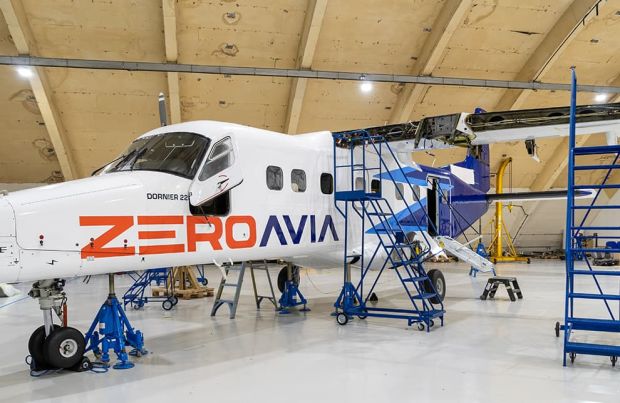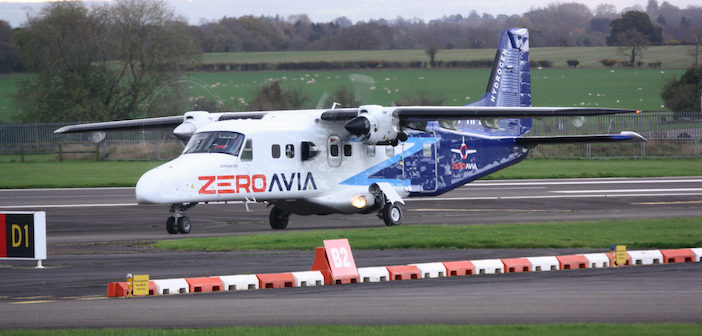|
A potential solution to carbon-free flying is inching closer to reality. Since the start of this year, small planes equipped with hydrogen fuel cells have made their first test flights over the U.S. West Coast and the English countryside. The aviation startups ZeroAvia and Universal Hydrogen now claim their novel aircraft will be ready to start flying commercially as early as 2025. A new analysis suggests that, if the technology can scale, it could sharply reduce greenhouse gas emissions for certain planes — and potentially lay the groundwork for decarbonizing broader swaths of the global aviation market. Retrofitting a propeller plane with fuel cells and liquid-hydrogen tanks would result in a nearly 90 percent reduction in life-cycle emissions, compared to the original aircraft, according to the International Council on Clean Transportation (ICCT), a nonprofit think tank. That’s assuming the hydrogen is made using only renewable electricity —not with fossil fuels, the way the vast majority of hydrogen is produced today. Fuel cells work somewhat like batteries. On planes, hydrogen flows into the fuel-cell system and spurs an electrochemical reaction that produces electricity; this in turn drives electric motors and spins propellers. But barring a technological breakthrough, fuel cells can’t produce enough power to carry the large, long-distance aircraft that are responsible for the bulk of aviation’s carbon dioxide emissions. Instead, the tech will likely be restricted to short-haul, turboprop airliners that can seat roughly 50 to 60 passengers and fly just a few hundred miles, such as the distance from New York City to Washington, D.C. Today’s turboprops represent about 1 percent of global passenger traffic. Still, experts say fuel cells could help pave the way for larger and more powerful hydrogen models, including potentially jets with combustion engines that burn liquid hydrogen. Airbus and Boeing, the world’s top two aircraft makers, are both developing hydrogen technologies as the industry faces growing public pressure to address climate change. “The introduction of the fuel-cell aircraft will be the testing ground for just generally using hydrogen in aviation,” Jayant Mukhopadhaya, aerospace engineer and a Berlin-based researcher for ICCT, told Canary Media. “How will it work at airports, how is the refueling going to happen, how does hydrogen get delivered, what safety concerns you’re going to have — all of those bits and pieces.” Why hydrogen is gaining favor Around the world, commercial air travel accounts for over 2 percent of energy-related CO2 emissions, according to the International Energy Agency. That number is set to soar in the coming years as more oil-burning planes and more passengers hit the skies. In the near term, airlines and plane manufacturers are working to curb emissions by designing more fuel-efficient engines, electrifying ground operations and increasing their use of “sustainable aviation fuel” made from used cooking oil, forestry residues, carbon dioxide and other feedstocks. Last year, alternative fuels accounted for less than 0.1 percent of the total jet fuel used by major U.S. airlines. Although plant- and waste-based fuels can be cleaner to produce than petroleum-based fuel, they still emit carbon dioxide when burned in engines. Hydrogen does not — that’s why airlines and manufacturers are joining efforts to develop H2-powered aircraft. Fuel cells in particular don’t generate harmful nitrogen oxides or fine particulate matter, since they don’t burn fuel. A retrofitted fuel-cell aircraft would emit about one-third less CO2 over its lifetime than an aircraft burning “e-kerosene,” a type of sustainable aviation fuel made from electricity, water and carbon dioxide, according to the ICCT analysis. Hydrogen, especially of the “green” variety, costs significantly more to make and buy than conventional kerosene. However, because fuel-cell systems are far more energy-efficient than engines, aircraft don’t need to use as much fuel to fly. If green-hydrogen production ramps up and fuel-cell aircraft catch on, it could be cheaper to refuel with H2 than fossil jet fuel in the United States in 2050, the ICCT said in a white paper published on Wednesday.
“The most surprising part was the [energy] efficiency impacting the price of fuel,” Mukhopadhaya said. “That was something we weren’t expecting.” Hydrogen aviation takes first flightsZeroAvia and Universal Hydrogen, both headquartered in California, have spent the first half of 2023 testing and demonstrating some of the world’s first hydrogen fuel-cell aircraft. In January, ZeroAvia first launched its 19-seat prototype plane at Cotswold Airport, a private airfield near the English village of Kemble surrounded by farms and grazing sheep. The blue-and-white Dornier 228 has now flown 10 times, hitting key milestones and enabling the company to begin the next phase of flight testing. ZeroAvia, which has raised over $140 million from investors including United Airlines and American Airlines, retrofitted one side of its twin-engine turboprop with fuel cells and batteries, which can reach a maximum power of 600 kilowatts. The other side kept its oil-burning jet engine. Over the course of six months, the aircraft reached a maximum speed of 150 knots, flew to a height of 5,000 feet and performed an endurance test for 23 minutes. “There was no malfunction of the fuel cell during the flight-test campaign,” Gabriele Teofili, ZeroAvia’s head of aircraft integration and testing, said on a recent call from the airport’s hangar, tilting his laptop to show the prototype parked behind him. Teofili said the company successfully demonstrated to the U.K. Civil Aviation Authority that the hydrogen-electric system behaved as expected — and that the aircraft has enough range to fly to another nearby airport. ZeroAvia is now preparing to begin its first cross-country flights in England before the end of this year. It’s also working to retrofit a second regional turboprop in Washington state, in partnership with Alaska Airlines. “The idea is to demonstrate that it’s not only possible, but it’s safe, it’s reliable, and it’s profitable,” Teofili said of the hydrogen aircraft. He noted that ZeroAvia plans to shed the batteries and engines that it’s using during testing to deliver a final aircraft powered only by a 1.8-megawatt fuel cell. The company claims it’s on track for commercial operations in 2025, starting with a nine- to 19-seat aircraft with a 300-mile range. Meanwhile, Universal Hydrogen says it’s making progress on an even bigger retrofitted turboprop. The company has raised at least $82.5 million from investors such as GE Aviation, American Airlines and the venture capital arms of Airbus, JetBlue and Toyota. In March, the Los Angeles–based startup launched its first test flight from a small airport near Moses Lake, Washington. Its 40-passenger Dash 8 prototype has one original engine, plus a 1.2-megawatt fuel cell and 800-kilowatt electric motor, with no batteries. Mark Cousin, Universal Hydrogen’s CTO, said the aircraft has flown nine total times, including a series of trips from Washington down to Mojave, California, where the plane now resides. The prototype climbed up to 10,000 feet high, hit speeds of 170 knots, and operated for more than an hour in flight. The company is continuing to test key elements of the hydrogen powertrain, including the cooling system that keeps the fuel cell from overheating — a challenge that can limit the technology’s performance and range. Universal Hydrogen is also preparing to ground test a 2 MW powertrain on an ATR 72 turboprop, which could begin flight-testing in 2025, Cousin said. The company aims to enter a hydrogen-fueled aircraft into passenger service later that year or in early 2026. Both ZeroAvia and Universal Hydrogen are using hydrogen in its gaseous form to power fuel cells during flight testing, though the companies plan to use liquid hydrogen eventually. The fuel is less widely available today, but it packs more energy on a volume basis than gaseous H2 and can be stored in fewer, lighter tanks on the aircraft. Along with retrofit conversion kits, Universal Hydrogen is also developing liquid-hydrogen storage capsules. The idea is to collect hydrogen from electrolyzer plants, which use water and renewable electricity to produce “green” hydrogen — and today remain few and far between. Trucks or trains would then transport the capsules to airports. Cousin said the company’s ultimate goal is to convince airlines and major airplane manufacturers that it’s possible to develop the necessary infrastructure for powering larger hydrogen-burning aircraft. Airbus, for instance, is building a demonstration engine to test hydrogen propulsion in one of its A380 superjumbo jets. “The real objective is to demonstrate not only that we can fly a [turboprop] on hydrogen, but also to demonstrate that hydrogen propulsion…is a viable solution for short- to medium-range operations,” he said.
0 Comments
Leave a Reply. |
Send us an email at [email protected] if you want to support this site buying the original Division of Aero Patch, only available through this website!
All
|



 RSS Feed
RSS Feed